Quest for Gold - the process is multi-step when it comes to extraction gold-bearing orenot a search for with a metal detector lost items. But either option requires knowledge and effort. In order not to waste time on an aimless search, they study the geology of the area, determine the most likely regions where the noble metal could theoretically be contained in the bowels of the earth. To do this, they consider different waysHow to find gold: study statistics on the content of old prints, look for signs on the banks of rivers, in the depths. They also use auxiliary equipment, among which must be a metal detector.
The beginning of the search for gold in ancient Russia. The first nugget. Types of natural gold and its properties
Many rulers in Russia made attempts to find gold deposits, but all were unsuccessful. Among them Ivan III, Ivan the Terrible. Around that time Siberia was conquered. Some success was achieved only by Peter I. During his reign, articles of clothing and jewelry made of the noble metal began to appear.
But even then, the development of gold mining did not develop at a rapid pace.
The first nugget was discovered in 1945. It happened in the Urals. At that time, only small particles of gold were found not far from the site where the first nugget was found. The search was stopped, but 2 years later it was resumed, which marked the beginning of the production of gold-bearing ore. At the bottom of the mine a substantial gold reserve.
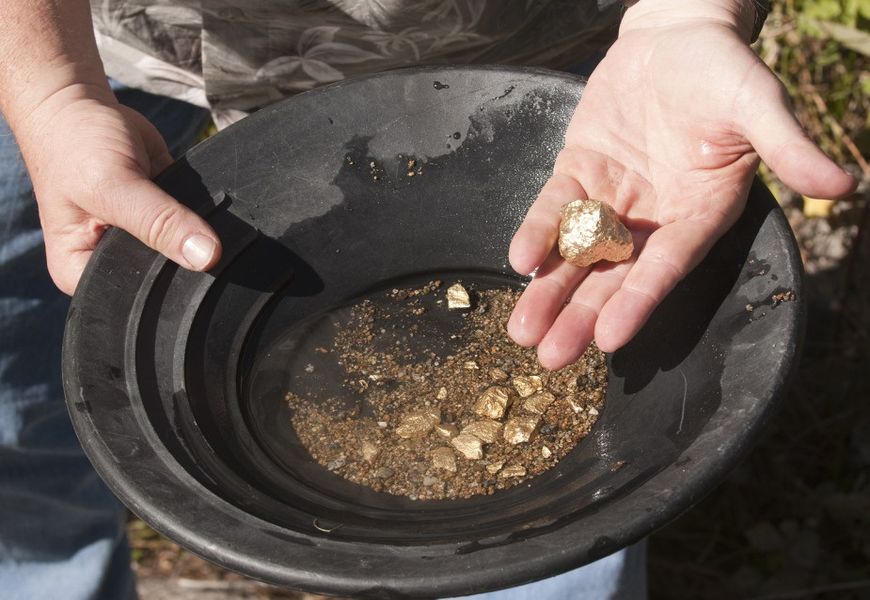
Mining native gold. It is distinguished by its composition, structure: the shape of crystals can be different (cube, octahedron, dodecahedron). It is a natural solution of silver, which is contained in gold, but the composition also includes various impurities (iron, copper, etc.). The types of noble metal in nature, which have a natural origin, are distinguished by their crystals:
- finely dispersed (up to 10 microns);
- dusty (up to 50 microns);
- small (0.05-2 mm);
- visible (up to 4 mm);
- nuggets (1-5 g, less often up to 10 kg).
Places where you can find the noble metal in nature
More often than not, there are no obvious and too obvious signs that it is in this particular area in the bowels of the earth that gold-bearing rock is formed. To find deposits, first of all, attention is paid to certain places where high pressure and elevated temperature took place. The most common places to look for gold-bearing rock are considered:
- rocks: gold crystals are constant companions of iron, so one sign of their presence is black sand (magnetite), also precious metal particles and nuggets are formed in quartz, which can also serve as a sign to which you can orient when searching for gold;
- mountain rivers and streams, including dried up, with high banks: you can start searching with a metal detector, examine dried up river mouths, where was conducted gold miningThe most attentive prospector will find crystals in the areas where the river has been flowing for a long time (the terrain may have changed, so old maps are studied);
- seawater: search gold could also be conducted in bodies of water, but this is not easy to arrange, as there are no effective and sufficiently environmentally friendly methods of implementing such an idea yet, but experts claim that it would produce 10,000,000,000 tons of precious metal.
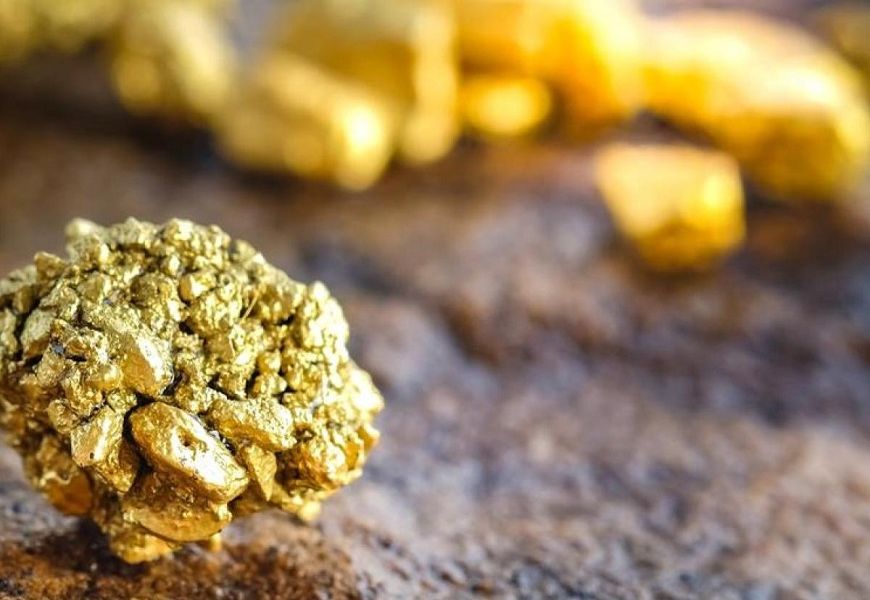
Prospective gold-bearing regions in Russia
Looking for gold crystals, nuggets look at the territories:
- Krasnoyarsk Territory;
- Amur region;
- Ural;
- Yakutia;
- Chita region;
- Irkutsk region.
Chelyabinsk region is the oldest gold mining region in Russia
Gold clusters in mountains and rivers
The gold is inferior to the ore reserves. It is believed that it is spread by water - washed to the surface. But crystals always move with the ore, which is due to their substantial mass. The particles trapped inside the rock (minerals) are released when the quartz pebbles deform. They are carried away by a rushing stream, a river. The pebble minerals remain where they have been broken. And this does not mean that there are not even smaller particles inside, i.e. crystals. Accordingly, the gold in the ground is found in different areas, connected by a network of reservoirs, but in some places, its content is higher.

Top 10 golden Russian rivers
In different sources from time to time there is information that certain rivers are aquifers. In such areas the precious metal is most abundant. The list of water bodies containing the largest amount of gold particles:
- Lena River basin;
- р. Bom;
- Millionny brook;
- Jalon creek;
- р. Unaha;
- р. Bolshoi Chanchik;
- р. Bodaibo;
- Alekseevsky brook, is located in Kamchatka Krai;
- р. Talga;
- р. Sanarka.
Where to start your prospecting. Popular literature on gold mining
Many people are still following in the footsteps of the gold rush period miners. They consider other areas where gold-bearing ore is formed, but they all make the same steps. We need find outhow find the gold in the ground.
To do this, the beginner should study the theory: determine the signs of the occurrence of gold crystals, lift the printed editions of past years in the archives. It is necessary to look for references to the development of the gold-bearing vein.
Literature is studied, which contains the basics of the precious metal mining process, recommendations. It describes the technology used, the methods. You can learn about all this from the book "Where to Look for Gold. A Practical Guide to Finding and Mining Gold" by Rudolf Kawczyk. You can download it, but most of the time you can find an incomplete version online. When ordering, you are offered to choose any region of the Russian Federation (from Altai to Moscow region), Kazakhstan and others.
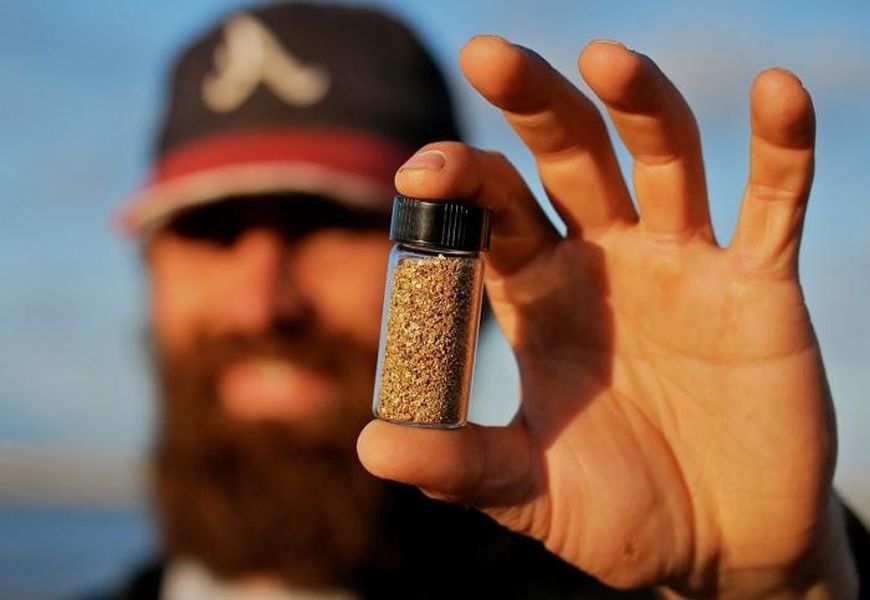
Geological analysis of the deposit
When the front of work was determined, found an area where a number of indicators should be nuggets or at least inclusions (particles, crystals, gold dust), begin to assess the parameters of the soil. A geological analysis is carried out:
- the structure and composition of the soil is studied;
- signs of gold-bearing ore are detected;
- all necessary analyses are performed, some of them are performed directly in the field, including mineralogical, which allows you to assess the prospects of the object, where it is planned to work.
At the same time, the search for primary deposits is carried out, because due to the geological analysis the areas of placers of gold crystals are determined. These processes are interconnected, because placers are always located near the primary deposits.
Based on the results of geological analysis, determine which mining method is the most rational: open pit, underground.
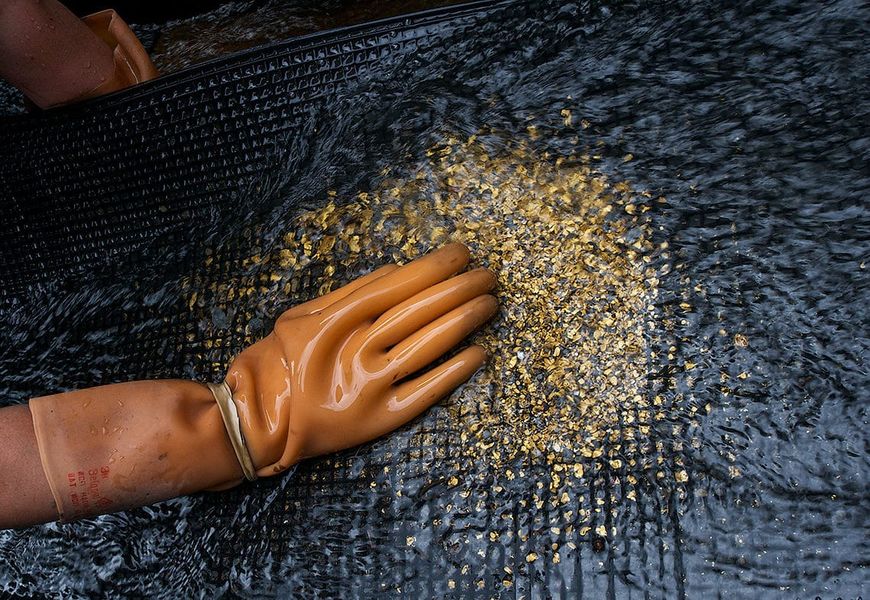
Types of gold deposits in nature
It is not reasonable to simply dig in arbitrarily defined places. It is necessary to verify that the natural wealth in the form of gold-bearing ore deposits is located exactly where the decision to start work was made. Clear signs of the presence of gold particles are found when deposits are identified, among them:
- quartz beds containing pure gold: the most common form of gold-bearing ore, found in two types (gold-quartz, gold-sulfide-quartz);
- eluvial deposits at the foot of the mountains: formed on the slopes of the mountains - near the root source;
- Alluvial: distributed as particles over considerable distances, the source of formation is the mountain, from the slopes, the crystals together with the rock are spread over the surrounding area, the river contributes to this, knowing this feature, it will be easier to determine where you can find gold;
- Residual deposits near the lode: gold is produced by natural processesIn which residual endogenous particles of the precious metal are overgrown with exogenous gold, which contributes to the enlargement of the nuggets;
- terraced deposits at the bottom of the river: as the river flow erodes the bottom, terraces are formed on the ledges of which gold-bearing ore particles are deposited;
- bottom sediments at the bottom of rivers in the form of sediment: they, like terraces, are a type of alluvial sediment, pebble mineral rock remains at the bottom because of its weight, in such places particles of precious metal can still be found, if the field is not yet being developed.

Where and how to look for gold - a practical guide, the algorithm of the search
From time to time information pops up about gold prospecting, development of deposits in the Volga region, Zheleznogorsk and Miass, Stavropol, Yurievets in the Caucasus, in the Transbaikal region, Uzbekistan, Bashkiria and even in the Moscow, Rostov region and Gelendzhik. But not everywhere is actually found evidence that ore containing gold crystals was found in the area. It is necessary to verify the data obtained. When studying the information, where to look for gold, a practical guide to action for beginners in gold prospecting will help to act step by step, without missing anything:
- Determination of the mining region: study all sources (including old newspapers), collect the stories of local residents, which will allow to find an area where the probability of finding the nugget is higher than in neighboring regions;
- study of the geologists' map and landscape: it is necessary to carefully review the names of the rivers, it often happens that the field gets the appropriate name with the prefix "gold", this is what you should look for on the map, the median of such names may mean that previously there was gold-bearing ore mining;
- Work in a group: it is desirable to find a partner or gather more people, as it is dangerous to search the field by yourself (you can get hurt, and there is a risk of meeting with competitors, who are usually unkind);
- Preparation of equipment (metal detector, blower, rake): buy a metal detector (popular models: ACE 250 Garrett, Minelab GOLD MONSTER 1000), the development of dry field using homemade equipment - blower, to work with it needs a partner (blow fur), the second gold digger will work with minerals with a rake, shovel;
- study of the territory, the secrets of gold settling in rivers and streams: knowing the characteristics of the climate, stream flow, its behavior in winter/summer, the speed of flow, estimate the intensity of spread of gold crystals, it is important to understand how the processes of settling of rock containing the precious metal to the bottom develop, and why not all particles are released from the mineral inclusions.
Interesting: While resting in the mines, one should not go to bed in gold, because there is an omen that this will cause the loss of jewelry in life, which may "disturb" the prospector, who is engaged in mining the precious metal.
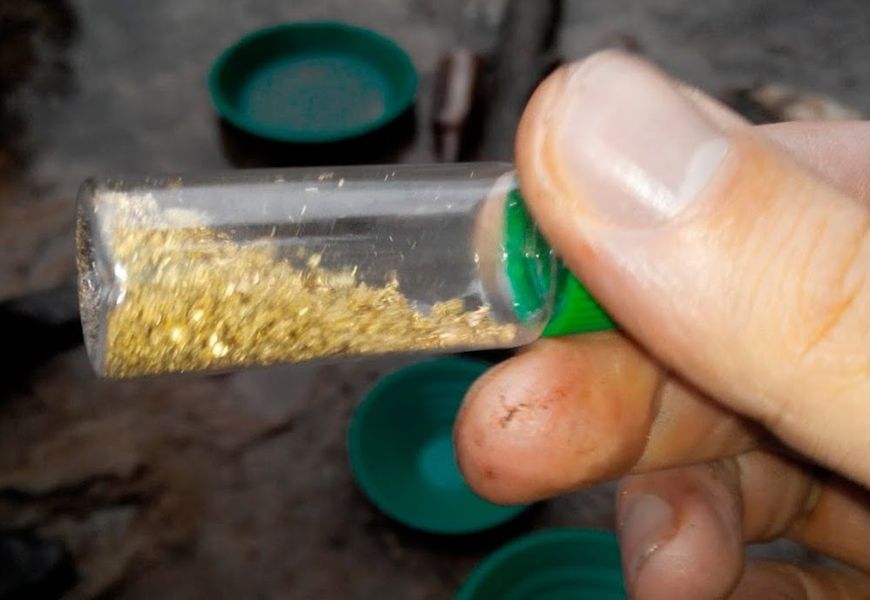
Search Methods
It is necessary to understand how to look for gold, which selects the most available technology with which even novices in the search for gold will be able to determine where the inclusions of precious metals:
- Pebble: to mine for gold, they use metal detectors, using them to detect mineral pebbles among river bed sediments, the complexity of the method is that you need to know exactly where to look for gold in Russia, otherwise you have to "call up" all the rivers in the region, which are within search radius;
- search by dumps: as a basis take a geological map where ore dumps are marked, if you find traces of quartz (the rock may contain small particles of gold) explore the area more carefully;
- kopushey method: based on the study of mine workings on a small scale (where trenches remain - zakopushki or kopushey), the method is used when there are no ore piles.
"Fishy" spots for diggers in mountain streams
When going in search of gold nuggets, it is necessary to have an idea of where the precious metal can be obtained. There is a high probability of finding crystals in the beds, mouths of rivers and streams, because it is the water that carries real nuggets and fine dust of the precious metal. The most "fishy" for diggers are areas where mineral deposits have already been found. It is great luck to find a large formation, but more often smaller nuggets are found.
Important: Next to the deposit, gold crystals are located at a certain distance from each other. If one has been found, you cannot stop searching - there must be other formations near it. This is the magic of the gold search process: there is a certain algorithm based on natural phenomena, which gradually reveals all the crystals of the precious metal in the area where the work is done.

Methods of mining solar metal
After gaining an idea of where the particles of precious material come from in the river, the gold prospector will soon know where to look for them, as this reveals the relationship between the formation process and the distribution of the crystals. When he finds one, he can take every last nugget in the area. In order to do this, effective methods are considered.
Application of the metal detector. The most popular models
For the purpose of precious metal detection requires the use of certain types of metal detectors:
- X-terra 505;
- Garret AT Gold;
- Nokta Gold Finder;
- Fisher Bug DP.
When the question of where to look for gold is studied, a practical guide begins with recommendations on the correct choice of a metal detector, because thanks to this device it is possible to find precious crystals. At the same time take into account its purpose (for the beach, water, etc.). The device searches for metal with different efficiency, which means that it is necessary to buy a model capable of detecting the smallest fractions.
The depth of the ground scan is also important.

Flushing gold dredge. Cost of equipment
Dredge - equipment representing the realization of the simplest method of gold mining, helps to extract the rock from the river, but leaves behind a bed in poor condition. The average price is about 116,000 rubles (mini-dredge).
Rinse by hand in a special tray. Instructions for use
The main rule is to wash above the river mouth (at least 500 m). The method allows you to get mainly small-sized particles rather than large nuggets. Instructions:
- Prepare a tray, a container of water, a reagent that will reduce the ability of particles to float, they will settle to the bottom.
- They add ore.
- The tray is filled halfway.
- Leave the ore to get completely wet (10-15 seconds is enough).
- The water with impurities is drained out.
Video: Preparing to search for gold deposits
Forms of pure gold in nature
The coverage of gold-bearing ore that is ever mined depends on its type. This is due to the fact that some of the particles are easier to find than others. Such possibilities are determined by the shape of the gold:
- gold sand placers - exogenous ore, represented by rolled grains (pebbles), dust-like particles, aggregates with quartz (spread at some distance from the core deposit)
- ore gold in quartz rocks - endogenous ore, located within strata underground, forming plate-like deposits, veins and vein deposits.
Forms of nuggets in nature. Unique names
When a prospector digs the ground, mining ore that is located underground or in the surface layers of river mouths, he has no idea that he may find a large formation - a nugget. Forms:
- dendrites are branching fusions;
- partially faceted formations;
- isometric polyhedrons;
- inclusions of irregular shape, flattened, elongated, etc.
Given the shape, the nuggets are given names:
- "Hare Ears;
- "Mephistopheles;
- "Camel.
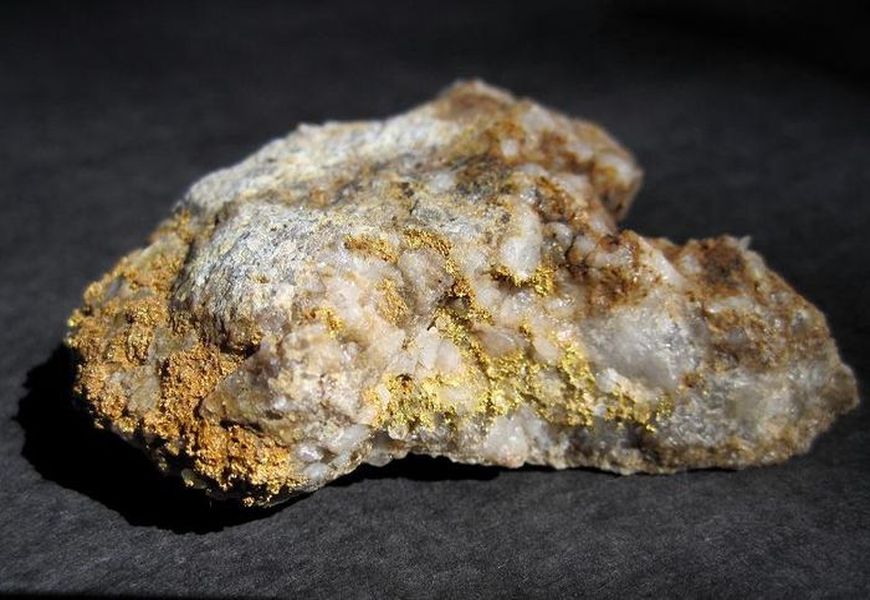
Composition and admixtures of nuggets. Natural alloy-electrum
Formations of precious metal particles cannot be contained in pure form, always include impurities:
- iron;
- mercury;
- bismuth;
- copper;
- silver, etc.
Nuggets most often contain silver (the most significant portion). Its combination with gold affects the color of the formation of precious metals - they become greenish. Such an alloy has its own name: electrum. The content of other metals is minimal.
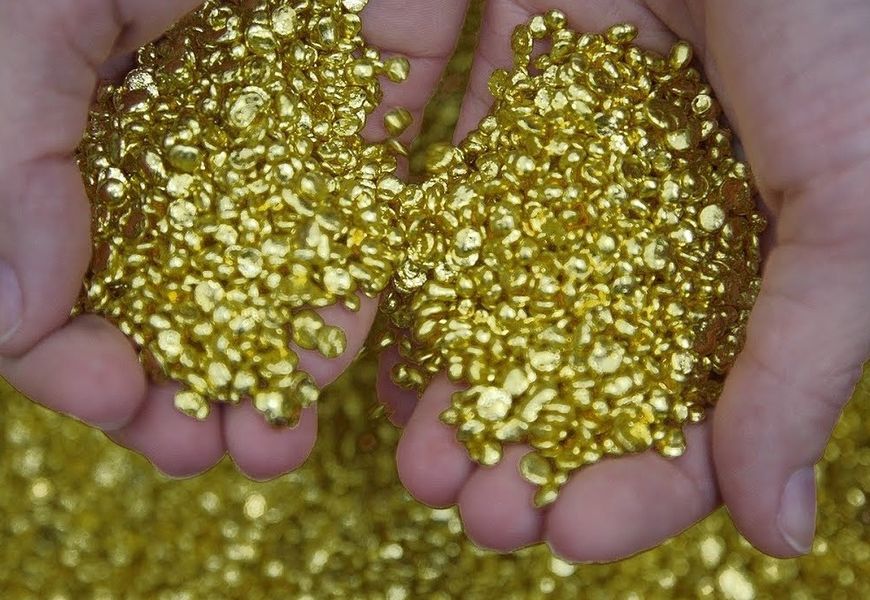
The legal side of gold mining by a private person
It is possible to find a real nugget in the ground and even bring it home, but it is important to understand what the law says about it. Changes in the legislation regulating the mining of ore containing gold crystals are now being considered. In this case, they limit the period of exploitation of the plots where the work is done, as well as determine their size.
Interesting: in Australia, the procedure for obtaining a license takes seconds. It can be obtained by any citizen of the country, and the validity of the document depends on the region (it is 1 year or a lifetime permit to mine gold).
Procedure for obtaining a license
Previously, only legal entities could be engaged in gold mining. Today it is also possible for natural persons, but only if a form of business is registered - IE. It is necessary to apply to a territorial body of Rosnedra to obtain a license to handle the precious alloy. The rights of possession of the plot for a statutory period can be obtained after submitting an application for participation in the auction. The documents that are required for this purpose are submitted. After winning, the license can be obtained.
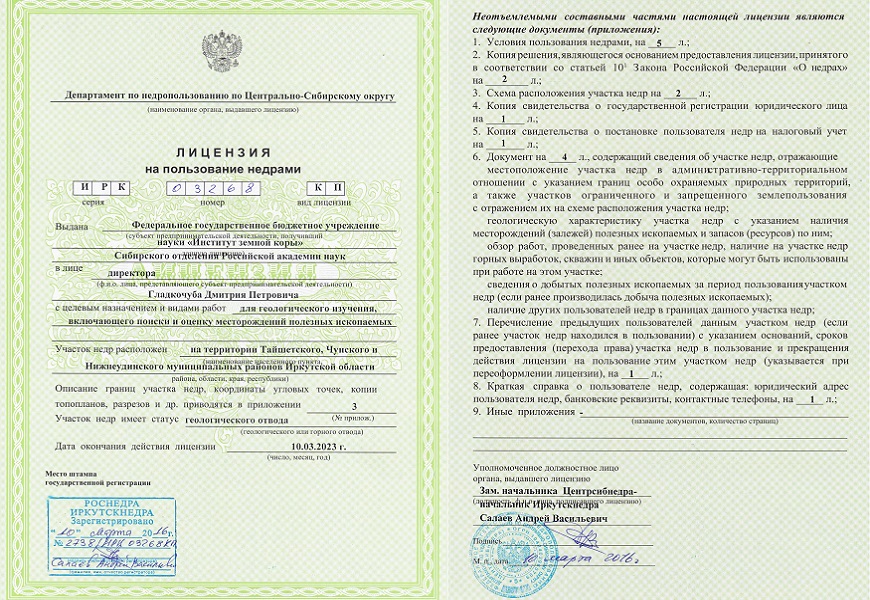
Conditions of precious metal mining
It is allowed to start work after obtaining a license, and its validity period varies:
- Up to 5 years - for FL;
- 20-25 years - for the UL.
Restrictions are imposed on the activities of individuals when using heavy machinery. In addition, private individuals may only dispose of areas with little prospect or landslides left after the completion of work by another organization. And these restrictions are quite legal.
Question and answer section
At what depth is the pebble of gold?
Where can I find gold nuggets in Russia, and can I keep them?
What methods are rational in the search for gold?
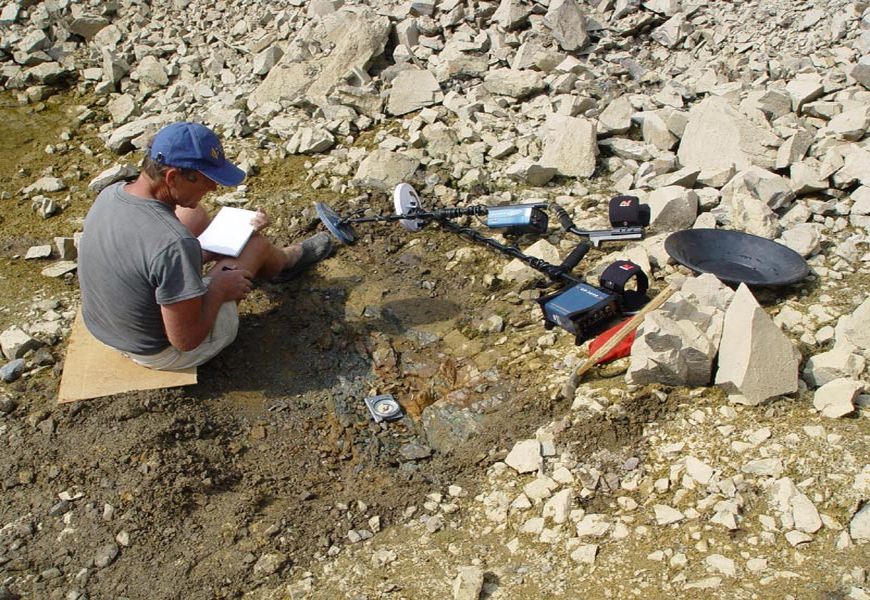
How to find gold in the ground. Gold mining on an industrial scale. Types of gold veins at different depths
- high-temperature (over 300°C);
- medium-temperature (200°...300° C);
- low-temperature (less than 200°C).
Alternative technologies for obtaining gold in the laboratory
Previously, cyanidation was used to extract gold from oxidized copper-bearing ores. Today, ammonium cyanide leaching technology is used. This allows the process to be accelerated Retrieved from gold from the starting material. As a result, it is remelted to make an ingot after going through the intermediate steps.
Video: laundering gold in mountain streams
Opinion of a geologist

Commentary from an experienced miner
Mining gold crystals beckons me like a magnet, I once left home, lived almost in the woods, working for free, looking for signs of precious metals. But still my guesses were confirmed, I first found small crystals, they resembled a barely noticeable sheen on the rock. The capacity of the equipment I had was enough to separate the larger particles, it helped to get up to speed to continue looking for a placer of gold crystals.

